256 Hydraulic System
For new vehicles, change the return filter element after 50 hours of use, and twice a year
afterwards or when the filter restriction indicator is in red (see Figure 5-20), whichever comes first
(see Replacing Filter Elements on page 282).
Clean the strainer inside the hydraulic tank after the first 50 hours of use, and twice a year
afterwards or when the filter restriction indicator is in red (see Figure 5-20), whichever comes first
(see Cleaning Strainer on page 280).
Hydraulic oil must be replaced at least once a year, or when contaminated, or after a hydraulic
pump change (see Replacing Hydraulic Oil on page 283).
NOTE: The ball valve on the hydraulic tank must be completely open before engaging the pump or
starting the engine.
Labrie Enviroquip Group requires that the hydraulic fluid and return oil filter be changed and that the
strainer be cleaned before changing the hydraulic pump.
Manufacturer’s warranty on hydraulic pumps provided or sold by Labrie Enviroquip Group could be
declared void if the hydraulic fluid and return oil filter are not changed, and if the strainer is not
cleaned prior to replacing the hydraulic pump.
Therefore, it is mandatory to change the return oil filter and clean the strainer after the first 50 hours
of use and then twice a year, or when the filter restriction indicator is in red (see Figure 5-20),
whichever comes first. The hydraulic fluid must be changed once a year. Hydraulic fluid
contamination will severely damage hydraulic components.
It is recommended to have the hydraulic fluid tested and analyzed by a lab to prevent hydraulic
system or pump breakdown. This will also optimize the frequency of hydraulic fluid changes. Labrie
vehicles are now equipped with an “oil sampler coupler.” For more information, see Testing Hydraulic
Oil on page 237.
NOTE: Evidence of maintenance and/or fluid samples could be requested when filling out warranty
claims concerning the hydraulic system or pump.
Hydraulic Vane Pump System
Two types of vane pumps are used on our EXPERT™ units: single vane pumps and dual vane pumps.
Usually, the single vane pump is used on units not equipped with an automated loading arm and the
dual vane pump is used on all other E
XPERT™ units.
The hydraulic vane pump is a high-efficiency pump that can be used at lower RPMs than gear pumps,
that is between 750 and 1200 RPM. This results in lower fuel consumption and less noise, which
increase the operator’s safety. It also can achieve higher pressure settings (3000 PSI).
The vane pump is a constant drive pump that can be linked with the engine crank shaft. On some
units, the vane pump can also be linked to the PTO transmission, through a drive shaft or an
extension shaft. In both cases, there are two possible configurations: constant drive or hot shift.
In a constant drive system, the pump is synchronized with the engine. It uses an electric solenoid
dump valve to send the hydraulic flow either to the system or back to the tank when not in use. The
dump valve limits the flow to the main valve to 45 gallons per minute (GPM). The pump (PTO)
switch found on the in-cab control panel controls this dump valve.
